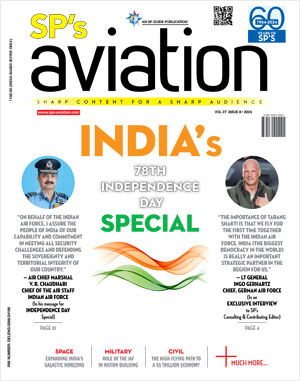INDIAN ARMED FORCES CHIEFS ON OUR RELENTLESS AND FOCUSED PUBLISHING EFFORTS

SP Guide Publications puts forth a well compiled articulation of issues, pursuits and accomplishments of the Indian Army, over the years

"Over the past 60 years, the growth of SP Guide Publications has mirrored the rising stature of Indian Navy. Its well-researched and informative magazines on Defence and Aerospace sector have served to shape an educated opinion of our military personnel, policy makers and the public alike. I wish SP's Publication team continued success, fair winds and following seas in all future endeavour!"

Since, its inception in 1964, SP Guide Publications has consistently demonstrated commitment to high-quality journalism in the aerospace and defence sectors, earning a well-deserved reputation as Asia's largest media house in this domain. I wish SP Guide Publications continued success in its pursuit of excellence.
Internet of Things: will LiFi replace WiFi?
 |
By Lt. General P.C. Katoch Former Director General of Information Systems, Indian Army |
Some 40% of the world population has an internet connection presently. In 1995, this figure was less than 1% but the dramatic increase commenced from 1999 with tenfold increase between 1999 and 2013. The first billion was reached in 2005, second billion in 2010 and the third billion in 2014. According to the report ‘Internet in India 2015’ released by the Internet and Mobile Association of India (IAMAI) and IMRB International, India was to have 402 internet users by December 2015 - the world’s second-largest overtaking the US. By October 2015, 317 million Indian users were accessing the internet, which was an increase by 49% compared to 2014.
China has the largest Internet user base, with over 600 million users. But what is revolutionizing the world is the Internet of Things (IoT). IoT networks the physical objects like devices and items embedded systems with electronics, software, sensors, enabling objects to exchange data with manufacturer, operator, other devices through network infrastructure, allowing objects to be controlled remotely across existing network infrastructure, creating opportunities for more direct integration of the physical world into computer-based systems, resulting in improved efficiency, accuracy and economic benefit. Applications of IoT can be infinite to include media, environmental monitoring, infrastructure management, manufacturing, energy management, waste management, safety management, medical and health care systems, building and home automation and transportation; encompassing technologies like smart grids, smart homes, intelligent transportation, smart cities etc. IoT can help computer manage and inventory objects and people, transforming daily lives.
You can have bottom up, convergence of data from IoT into applications, web-of-things providing civic engagement and data-driven decision making. However, question of security remains not only in terms of spying on people in their own homes but also cyber attacks in the physical world. That is why it is said that if one thing can prevent the Internet of things from transforming the way we live and work, it will be a breakdown in security. IoT presents opportunities for government to improve public services and enhance. This is what Prime Minister Narendra Modi aims to do through Digital India, ensuring government services are available to citizens electronically by improving online infrastructure, increasing Internet connectivity and connecting rural areas with high-speed internet, the three core components of Digital India being: creation of digital infrastructure; delivering services digitally; and, digital literacy. As per the ‘Internet in India 2015’ report, In Urban India, the mobile internet users was 197 million in October 2015 and by December this figure in In Rural India was expected to reach 87 million and 109 million by June 2016. 94% users access the Internet through their mobile phones in Urban India. 77% of urban non-working women who access the internet also do so from their mobiles. This is due to advent of low-cost smartphones and reasonable tariffs, empowering consumers in hinterland also to use data connectivity. That is why you find talk of provision of WiFi in numerous places. But advances in technology are too rapid to fathom and so we may see WiFi being replaced by LiFi (Light Fidelity) in the not too distant future, the big advantage of LiFi being its lightening speed; smartphones could be connected to internet with a lamp giving 100 times faster access than WiFi.
At the Mobile World Congress held from 22-25 February 2016 in Barcelona, Spai,n French company Oledcomm demonstrated LiFI technology. As soon as a smartphone was placed under an office lamp, it started playing a video. Laboratory tests show theoretical speeds of over 200 Gbps by liFi. The technology uses the frequencies generated by LED bulbs -- which flicker on and off imperceptibly thousands of times a second -- to beam information through the air, leading it to be dubbed the "digital equivalent of Morse Code". According to a media report, LiFi started making its way out of laboratories in 2015 to be tested in everyday settings in France like museums and shopping malls. It has also seen test runs in Belgium, Estonia and India. According to Deepak Solanki, founder and CEO of Estonian firm Velmenni which tested LiFi in an industrial space during 2015, "Two years down the line the technology can be commercialized and people can see its use at different levels."With analysts predicting the number of objects that are connected to the Internet soaring to 50 million by 2020 and the spectrum for radio waves used by Wi-Fi in short supply, Li-Fi offers a viable alternative. With PM Modi’s emphasis on technology, the government would surely be looking to optimize LiFi.





